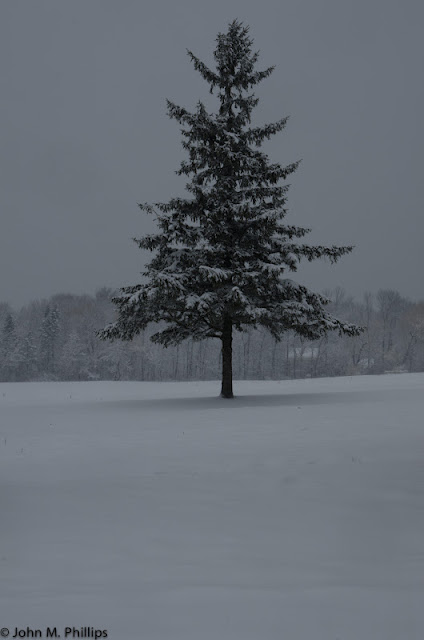Thursday night marked the first major snowstorm of the season. We got seven or eight inches in Mequon, and it was the wet, heavy sort that clings to the branches and trunks of the trees. Even though it was still snowing early on Friday morning, I decided I needed to get out to capture what I could before the sun and wind promised for later in the day took away those opportunities. I headed over the Virmond Park hoping that the snow still in the air would help to isolate subject matter from background.
This didn't work out as well as I hoped. Because the wind was up and driving snow from the northwest and the temperature was nearly at the freezing point, I was concerned about getting snow (that is, water) on the surface of my lens. So I felt I had to take my shots facing away from the wind. I also had some concern about getting my camera wet. Most of the shots I took were very forgettable.
Here is one of the shots that seemed to have some promise. This is how it looked as originally taken.
Unlike with some of the other shots, there is good separation between the subject clump of trees and the background trees that are washed out by the snow in the air. The shot was not without problems. As taken it looked dim and washed out. I had forgotten that all of the white snow in the image had fooled my camera's light meter into underexposing the shot, so the white snow was rendered gray. I knew I could increase the exposure in post processing. I also wanted to crop it slightly to eliminate the stake sitting in the lower right of the image. I felt that there was so little color in the shot that it would work best as a black & white. Here is how it looked after post processing.
By increasing the contrast and sharpening the image, I was able to bring out a lot of the detail of snow in the branches of the huddle of trees.
I showed this to Geri and showed her the comparison with the original shot. She stated that she actually liked the color better than the B&W. So I reconverted the image to color and worked some on it. I warmed up the white balance a bit and increased the color saturation. Here is the result.
I have to admit that I like the color shot better also. I think it is because there is contrast between the green of the evergreens and the brown of the background trees.
Here is another shot from Virmond Park of a tree that I have photographed in the past.
Again, very underexposed and a little "cold" in terms of white balance. First, I decided to crop to eliminate much of the foreground snow and decided to position the tree to the left of center. There is the roof of a home visible to the right of the tree that I wish was not there but there wasn't much I could do about that. I converted the shot to a B&W, increased the exposure and contrast, and sharpened the image. Here was the result.
Not terrible, but I wish that I had left more space around the tree in the shot as originally taken. Here is the shot converted back to color. As with the other shot, I warmed it up a bit and ramped up the color saturation.
Again, I like this result, although in this case I think I like the B&W version better.
Our subdivision includes a small patch of woods set behind a pond. On my way back from Virmond Park, I noticed that the wind had left snow on the east side of the tree trunks and thought the effect might be interesting. Again, here is the shot as taken.
Although this shot had some problems, I felt it also had good promise. Although it is underexposed, I knew I could remedy that. There are two small evergreens in the shot, but I knew when I took the shot that I would crop out the evergreen on the right. I also decided to crop out the edge of the pond which is visible at the bottom of the image. I decided it would be better to show the snow in the foreground as simply a pure white--almost as if the trees are suspended in air. Finally, when I converted it to a B&W, as usual, I increased the contrast and sharpened it some, to come up with the following.
I like this shot quite a bit, as I feel it does a good job of showing how the snow covers one side of the tree trunks and not the other. However, again I also turned it back into a color shot, warming it up some and increasing the color saturation.
This shot is similar to the one at the beginning of this post, but this one is helped a lot by the evergreen on the left. In addition, it is simply sharper than the earlier one.










No comments:
Post a Comment
Note: Only a member of this blog may post a comment.